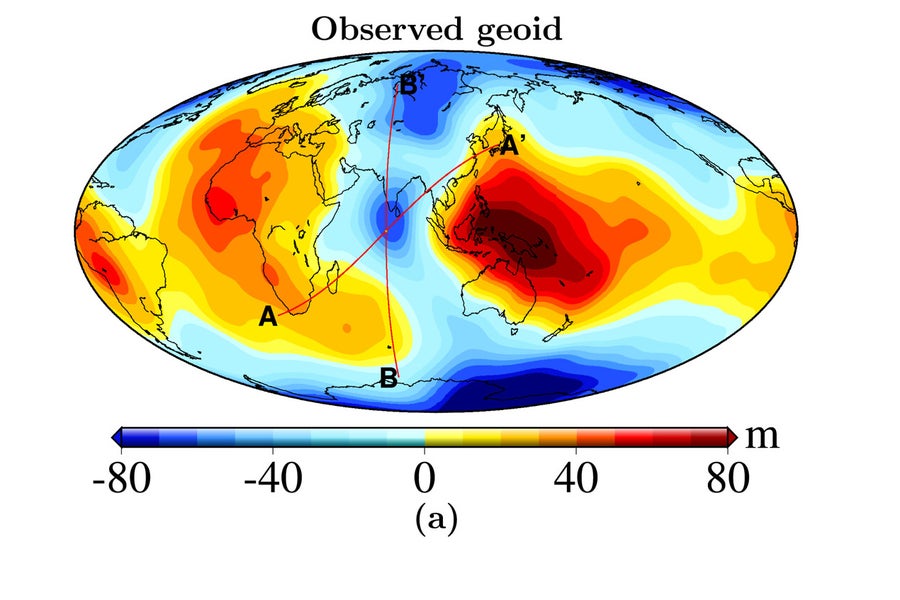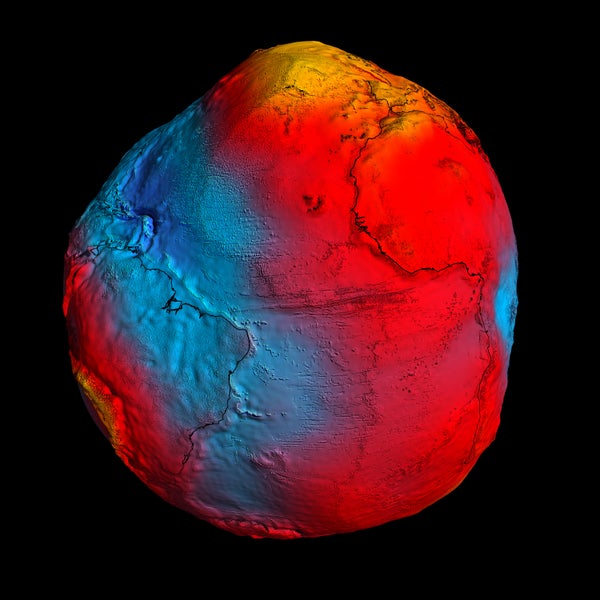There’s a massive “hole” in the Indian Ocean, researchers say—but it’s not the kind that could drain away all that water. Instead it’s a term geologists use to describe a spot where Earth’s gravity is lower than average. And a new study may have finally revealed its origins: it appears to be caused by plumes of molten rock rising from deep beneath Africa at the edges of the sinking remnants of an ancient ocean bed.
In an ideal universe, Earth would be a perfect sphere, and its gravity would be exactly the same at every point on its surface. But in reality, Earth is flatter than a true sphere around both the North and South Poles, and it bulges out near the equator. Additionally, different regions exert a different gravitational pull depending on the mass of Earth’s crust, mantle and core beneath them.
Local gravity measurements taken by ground-based sensors and satellites can be combined to show what the ocean’s surface would look like from those varying gravitational tugs alone, stripping out other influences such as winds and tides. This produces an exaggerated visualization of our planet’s gravitational high and low spots called the global geoid. One of the most famous models of this is known as the “Potsdam gravity potato” (named for the tuber it resembles and the location of the German research institute where it was developed).
On supporting science journalism
If you're enjoying this article, consider supporting our award-winning journalism by subscribing. By purchasing a subscription you are helping to ensure the future of impactful stories about the discoveries and ideas shaping our world today.
A pronounced dip in the geoid under the Indian Ocean—called the Indian Ocean geoid low (IOGL)—is the planet’s most prominent gravitational anomaly. It covers more than three million square kilometers and is centered about 1,200 km southwest of the southern tip of India. (Its enormity, as well as the fact that the ocean looks relatively flat at any given point, means the dip isn’t visible at the surface.) As a result of the low pull of gravity there, combined with the higher gravitational pull from the surrounding areas, the sea level of the Indian Ocean over the hole is a whopping 106 meters lower than the global average, says the new study’s senior author Attreyee Ghosh, a geophysicist at the Indian Institute of Science (IISc) in Bangalore.

This depiction of the observed geoid of the Earth shows gravitational highs (oranges and reds) and lows (blues), measured in meters. The Indian Ocean geoid low can be see off the southern tip of India. Credit: “How the Indian Ocean Geoid Low Was Formed,” by Debanjan Pal et al., in Geophysical Research Letters. Published online May 5, 2023
According to the study’s lead author Debanjan Pal, an IISc doctoral student, the IOGL was discovered in 1948 during a ship-based gravity survey by Dutch geophysicist Felix Andries Vening Meinesz. It has since been confirmed by other shipboard expeditions and by measurements from satellites. But scientists didn’t know why it was there.
To answer that question, Pal and Ghosh compared more than a dozen computer models of how the region formed over the past 140 million years as Earth’s tectonic plates have shifted around. Each model used different variables for the convection of molten material within the mantle.
The results, published in Geophysical Research Letters, indicate the IOGL is present because of a distinctive mantle structure, combined with an adjacent disturbance under Africa called a large low shear velocity province (LLSVP) that is more commonly known as the “African blob.” “What we’re seeing is that hot, low-density material coming from this LLSVP underneath Africa is sitting underneath the Indian Ocean and creating this geoid low,” Ghosh says.
Pal explains that the African blob, which largely causes the IOGL, is probably formed by “Tethyan slabs” deep in the mantle. Geologists think these slabs are ancient remnants of seafloor from the Tethys Ocean, which was located between the supercontinents of Laurasia and Gondwana more than 200 million years ago. Both Africa and India were part of Gondwana, but what is now India moved north into the Tethys Ocean—creating the Indian Ocean behind it—about 120 million years ago. “Plumes [of molten rock] arise when subducted slabs belonging to the old Tethys Ocean sink inside the mantle and reach the core-mantle boundary,” Pal says. “We also show that the surrounding mantle structures play a role in giving rise to this low, in addition to these plumes.”
Geophysicist Shijie Zhong of the University of Colorado Boulder, who wasn’t involved in the latest study, says it is an interesting and careful effort to better understand the IOGL. “We like to talk about the positive gravity anomalies, such as the superplumes over Africa and the Pacific,” he says. “But the geoid low in the Indian Ocean is one of the most profound gravitational anomalies on our planet.”
Pal says the geoid low probably took its present shape about 20 million years ago, when the plumes started to spread within the upper mantle. And it will probably last as long as mantle material flows along the plume from the African blob—which is likely to be many more millions of years. But once those flows cease, so will the low. “When the temperature anomalies causing this low geoid shift out of the present-day location,” Pal says, “the geoid low will start to dissipate.”
